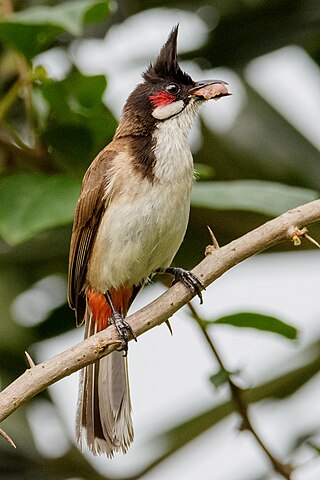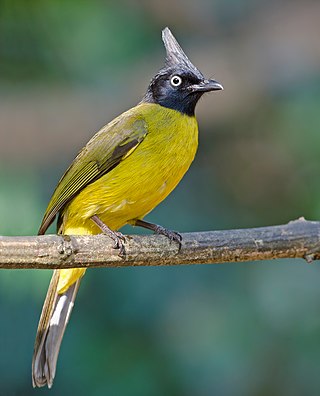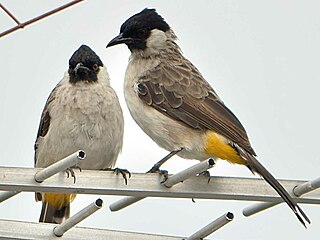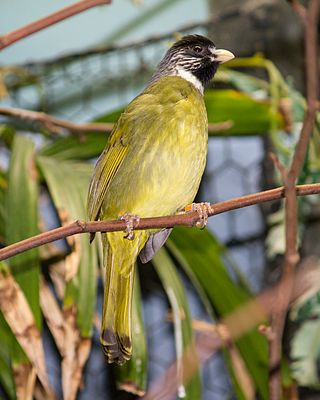
The red-billed blue magpie is a species of bird in the crow family, Corvidae. It is about the same size as the Eurasian magpie, but has a much longer tail, one of the longest of any corvid. It is 65–68 cm (25.5–27 in) long and weighs 196–232 g (6.9–8.2 oz).

The red-whiskered bulbul, or crested bulbul, is a passerine bird native to Asia. It is a member of the bulbul family. It is a resident frugivore found mainly in tropical Asia. It has been introduced in many tropical areas of the world where populations have established themselves. It has a loud three or four note call, feeds on fruits and small insects and perches conspicuously on trees. It is common in hill forests and urban gardens.

The red spurfowl is a member of the pheasant family and is endemic to India. It is a bird of forests, and is quite secretive despite its size. It has a distinctive call and is often hard to see except for a few seconds when it flushes from the undergrowth. It appears reddish and like a long-tailed partridge. The bare skin around the eye is reddish. The legs of both males and females have one or two spurs, which give them their name.

The black-crested bulbul is a member of the bulbul family of passerine birds. It is found from the Indian subcontinent to southeast Asia.

The black bulbul, also known as the Himalayan black bulbul or Asian black bulbul, is a member of the bulbul family of passerine birds. It is found primarily in the Himalayas, its range stretching from India eastward to Southeast Asia. It is the type species of the genus Hypsipetes, established by Nicholas Aylward Vigors in the early 1830s. There are a number of subspecies, mostly varying in the shade of the body plumage which ranges from grey to black, and some also occur in white-headed morphs, as also suggested by its specific epithet leucocephalus, literally "white head". The legs and bill are always rich orange-red.

The pin-striped tit-babbler, also known as the yellow-breasted babbler, is a species of bird in the Old World babbler family Timaliidae that is found in South and Southeast Asia.

The blue-eared barbet is a barbet in the Megalaimidae family native to mainland Southeast Asia. Because of its wide distribution and stable population it is listed as Least Concern on the IUCN Red List.

The ashy bulbul is a species of songbird in the bulbul family, Pycnonotidae. It is found on the Indian subcontinent and in Southeast Asia. Its natural habitats are subtropical or tropical moist lowland forest and subtropical or tropical moist montane forest.

The mountain bulbul is a songbird species in the bulbul family, Pycnonotidae. It is often placed in Hypsipetes, but seems to be closer to the type species of the genus Ixos, the Sunda bulbul. It is found in Southeast Asia and is not considered a threatened species by the IUCN. It is named after British East India Company Surgeon John McClelland.

The sooty-headed bulbul is a species of songbird in the Bulbul family, Pycnonotidae. It is found in south-eastern Asia. Its natural habitat is subtropical or tropical moist lowland forests.

The flavescent bulbul is a species of songbird in the bulbul family of passerine birds. Its name comes from flavescent, a yellowish colour. It is found in south-eastern Asia.

The striated bulbul is a species of songbird in the bulbul family, Pycnonotidae.

The brown-breasted bulbul is a songbird in the family Pycnonotidae. The species was first described by John Anderson in 1869.

Spizixos is a genus of passerine birds in the bulbul family Pycnonotidae.

The collared finchbill is a species of songbird in the bulbul family, Pycnonotidae. It is found in China, Taiwan, Japan and Vietnam.

The hairy-backed bulbul is a songbird species in the bulbul family, Pycnonotidae. It is the sole species contained within the monotypic genus Tricholestes. It is found on the Malay Peninsula, Sumatra, and Borneo. Its natural habitat is subtropical or tropical moist lowland forests.

The rusty-naped pitta is a species of bird in the family Pittidae.

The grey-throated babbler is a species of passerine bird in the Old World babbler family Timaliidae.

Blyth's shrike-babbler is a bird species found in the eastern Himalayas and Southeast Asia from northern Burma to southern Cambodia. Like others in the genus it is found in montane forests. Males and females have different plumages and variations occur through its range with several populations being treated as subspecies. It is part of a cryptic species complex and was earlier lumped as a subspecies of the white-browed shrike-babbler. Clements lumps this bird into the white-browed shrike-babbler.

Rubigula is a genus of Asian passerine birds in the bulbul family, Pycnonotidae.























